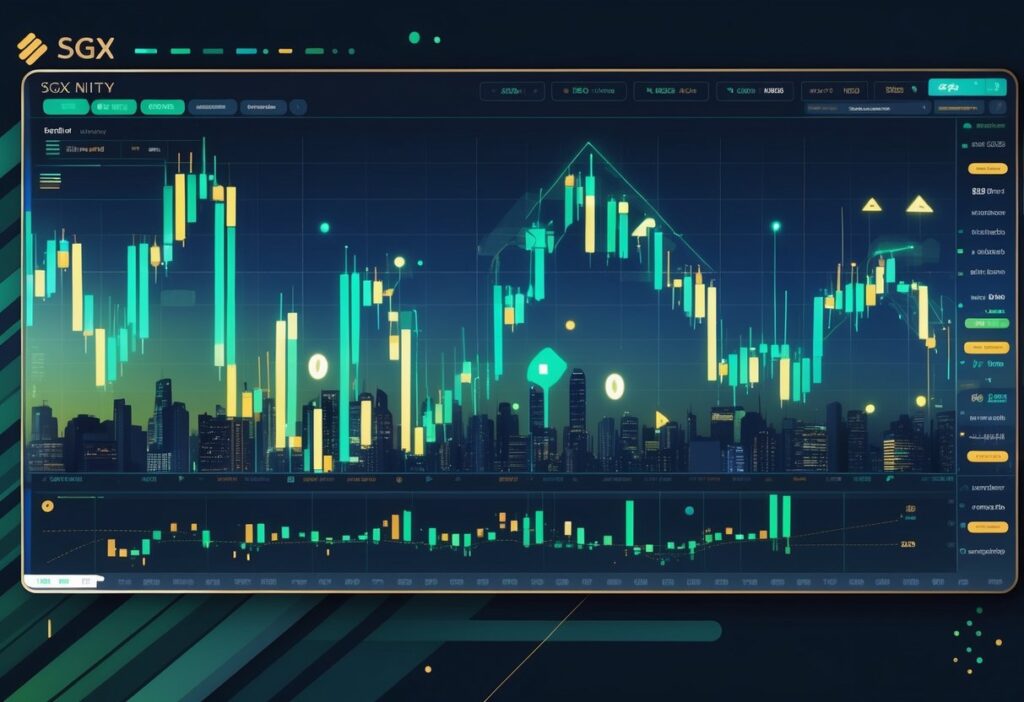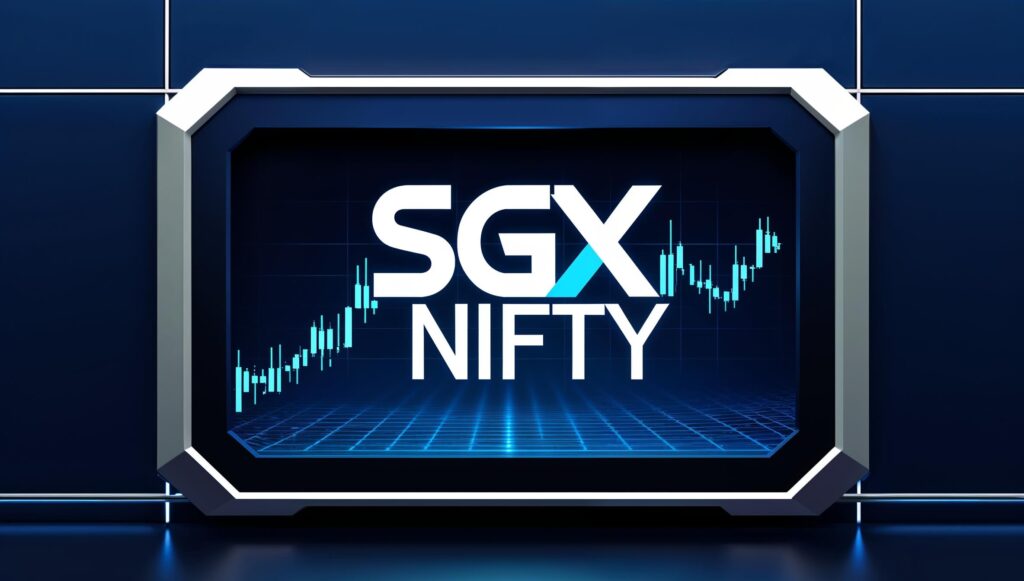SGX Nifty is a futures contract based on India’s Nifty 50 index that trades on the Singapore Exchange. It gives investors a way to trade Indian market futures even when the domestic markets are closed, making it a valuable tool for predicting opening prices. The SGX Nifty functions as a reliable indicator for early market movement in the Indian Nifty, helping traders prepare their strategies before the National Stock Exchange (NSE) opens for the day.

As someone who’s analyzed market patterns for years, I’ve observed how SGX Nifty provides critical insights into potential market directions. The SGX Nifty futures market shows strong connections with both Indian and global markets, especially with US market innovations significantly impacting its volatility. This relationship creates opportunities for traders who want to get ahead of market movements.
Key Takeaways
- SGX Nifty serves as a predictive tool for the opening price of Nifty in India, giving traders an early advantage before markets open.
- The futures contract traded on Singapore Exchange allows investors to react to global events affecting Indian markets outside of NSE trading hours.
- SGX Nifty shows strong correlations with both US markets and the Indian Nifty, making it valuable for developing effective trading strategies.
What Is SGX Nifty?
SGX Nifty is a futures contract based on India’s Nifty 50 index that trades on the Singapore Exchange. It serves as an early indicator for the Indian stock market and allows international investors to gain exposure to Indian equities outside normal trading hours.
Origin and Purpose
SGX Nifty emerged from a partnership between the Singapore Stock Exchange (SGX) and the National Stock Exchange (NSE) of India. It was created to provide global investors with access to the Indian markets even when the domestic exchanges were closed.
The primary purpose of SGX Nifty is to allow trading of Nifty futures contracts during Singapore trading hours, which start before Indian markets open. This gives investors an early indication of how the Indian market might perform that day.
Many international investors use SGX Nifty to hedge their exposure to Indian equities or speculate on the direction of the Indian market. The SGX Nifty live chart is often monitored by traders worldwide as it offers insights into potential opening trends for the NSE Nifty.
How SGX Nifty Differs From NSE Nifty
The main differences between SGX Nifty and NSE Nifty involve timing, accessibility, and regulatory frameworks:
Trading Hours: SGX Nifty trades during Singapore market hours (6:30 AM to 11:30 PM IST), while NSE Nifty trades during Indian market hours (9:15 AM to 3:30 PM IST).
Regulatory Oversight: SGX Nifty operates under Singapore’s regulatory framework, while NSE Nifty is regulated by Indian authorities.
Studies have shown strong linkages between the two markets, with SGX Nifty futures often serving as a leading indicator for the Indian Nifty 50 index. The price movements in SGX Nifty futures frequently influence the opening direction of the NSE Nifty.
Despite being based on the same underlying index, the two can occasionally show price differences due to factors like currency fluctuations, liquidity differences, and varying market sentiment.

Transition to GIFT Nifty
In recent years, SGX Nifty has been transitioning to GIFT Nifty, a similar futures contract traded at Gujarat International Finance Tec-City (GIFT City) in India. This shift represents a significant change in how international investors access Indian equity derivatives.
The transition was prompted by disputes between NSE and SGX over offshore trading of Indian derivatives. As a compromise, both exchanges agreed to shift these contracts to GIFT City, creating a new international financial hub within Indian territory.
GIFT Nifty offers similar benefits to SGX Nifty but operates under a special regulatory framework designed to attract international investors while keeping trading within India’s borders.
For traders, the migration means adjusting to a new trading platform while maintaining similar access to Indian market derivatives. The volatility spillover effects that existed between SGX and NSE markets are expected to continue in the new structure, preserving the price discovery function that made SGX Nifty valuable to global investors.
SGX Nifty Trading Insights
SGX Nifty futures provide critical market signals for traders worldwide, operating as a barometer for Indian market sentiment before NSE opens. This derivative contract traded on the Singapore Exchange offers unique advantages for international investors seeking exposure to Indian markets.
Trading Hours and Market Timing
SGX Nifty trading operates from 6:30 AM to 11:30 PM IST on weekdays, giving it a significant advantage over the NSE Nifty which trades from 9:15 AM to 3:30 PM IST. This extended trading window allows investors to react to global events that occur after Indian markets close.
The pre-market SGX Nifty levels are closely watched by traders worldwide as they often indicate the opening direction for Indian markets. I’ve observed that major moves in SGX Nifty after NSE closing frequently translate to gap-up or gap-down openings the following day.
Trading sessions overlap with multiple international markets, including:
| Market | Overlap Time with SGX (IST) |
|---|---|
| European | 1:30 PM – 11:30 PM |
| US | 7:00 PM – 11:30 PM |
| Asian | 6:30 AM – 3:30 PM |
This timing advantage makes SGX Nifty an invaluable tool for market timing strategies.
Key Market Participants
The SGX Nifty attracts diverse market participants, primarily dominated by foreign institutional investors (FIIs) and hedge funds seeking exposure to Indian markets. These investors prefer SGX due to its regulatory framework, USD-denominated contracts, and extended trading hours.
International investors from the US, Europe, and Asia constitute a significant portion of trading volume. Many institutional investors use SGX Nifty for hedging their Indian market exposure or implementing arbitrage strategies between markets.
Major participants include:
- Global hedge funds
- Foreign portfolio investors
- Proprietary trading firms
- Algorithmic traders
- Mutual funds with global mandates
SGX QUEST (Singapore Exchange Query and Estimation System) serves as the primary trading platform, offering robust technology for high-frequency trading and complex derivative strategies. The platform’s reliability makes it attractive for institutional trading.

SGX Nifty Futures and Derivative Contracts
SGX Nifty futures contracts mirror the NSE Nifty 50 index, providing international exposure to India’s benchmark index. These contracts are denominated in US dollars, making them accessible to global investors without currency conversion concerns.
The standard contract size is 2 times the Nifty index value, with monthly expiry cycles. SGX also offers options on Nifty futures, enabling sophisticated trading strategies like spreads, straddles, and covered calls.
Key features include:
- Margin requirements: Typically 5-10% of contract value
- Settlement: Cash-settled in USD
- Tick size: 0.5 index points
- Contract months: Current, next month, and quarterly
Research shows that SGX Nifty futures have strong cointegration with spot Nifty, making them effective for price discovery and hedging. The futures typically trade at a premium to spot prices, with the basis narrowing as expiration approaches.
Influence on Indian Stock Market Sentiment
SGX Nifty exerts significant influence on Indian market sentiment, especially during opening hours. I’ve noted that Nifty spot index often follows the directional cues from overnight SGX Nifty movements.
Price discovery analysis indicates strong volatility transmission between SGX Nifty and NSE markets. During major global events like US Fed decisions or political developments, SGX Nifty reactions provide early signals for Indian market participants.
The correlation between markets is particularly strong during:
- Economic data releases
- Corporate earnings seasons
- Geopolitical tensions
- Global market corrections
Traders use SGX Nifty trends for formulating day-trading strategies and managing overnight risk exposure. Technical analysis of SGX Nifty charts can reveal important support and resistance levels that often hold true when NSE opens, giving traders valuable insights for positioning.
Frequently Asked Questions
SGX Nifty futures trading involves complex market dynamics and timing considerations that impact trader decisions. The relationship between international markets and technical analysis plays a crucial role in predicting movements.
SGX Nifty futures are influenced by several key factors. Global market trends, especially from US and European markets, often set the tone for next-day trading.
Economic data releases like GDP numbers, inflation reports, and employment statistics can cause significant price movements. Corporate earnings announcements from major Indian companies also impact futures pricing.
FII (Foreign Institutional Investor) activity is particularly important, as their buy or sell decisions can create momentum in either direction. Technical factors such as support and resistance levels frequently determine short-term price action.
Dow Jones futures have a strong correlation with SGX Nifty movements. When Dow futures trend upward overnight, SGX Nifty typically opens positive the next morning.
This relationship exists because global markets are interconnected, with US markets strongly impacting SGX Nifty volatility. I’ve observed that major economic events in the US create ripple effects across Asian markets.
The correlation strength varies based on specific news and events. Sometimes Indian-specific news can override the Dow effect, creating independent movement patterns.
SGX Nifty live charts show candlestick patterns that reveal market sentiment. Green candles indicate buying pressure while red shows selling momentum.
Volume indicators accompany price movements to confirm trend strength. Higher volumes with directional price moves suggest stronger conviction among traders.
Technical indicators like RSI, MACD, and moving averages help identify potential reversal points. I recommend watching for convergence/divergence between indicators and price action to spot trading opportunities.
SGX Nifty opens at 6:30 AM IST, providing an early indication of market sentiment before the NSE opens at 9:15 AM. This 2.75-hour window gives traders valuable time to prepare strategies.
The opening often reflects overnight global developments that Indian traders must account for. I find that significant gaps between the previous NSE close and SGX opening can signal strong trading opportunities.
Early morning SGX Nifty movements help institutional and retail traders alike position themselves before the domestic market opens.
SGX Nifty futures and NSE Nifty maintain a cointegrated relationship, meaning they move in sync over time despite short-term differences. Research shows significant price discovery occurs between these markets.
SGX Nifty provides offshore exposure to India’s premier index. The price differential between SGX and NSE Nifty is typically minimal due to arbitrage activities that quickly eliminate major discrepancies.
These futures contracts serve as hedging instruments for institutional investors with exposure to the Indian market. They allow trading to continue when the domestic market is closed.
GIFT Nifty trades from 8:00 AM to 11:00 PM IST on the GIFT City exchange. This extended timeframe allows traders to react to global developments throughout the day.
The longer trading hours accommodate international investors across different time zones. I find this particularly useful for responding to US market movements that happen after NSE closes.
GIFT Nifty was introduced as an alternative to SGX Nifty with regulatory benefits for Indian market participants. It offers similar exposure with the advantage of trading through Indian infrastructure.





